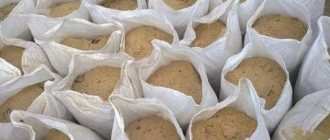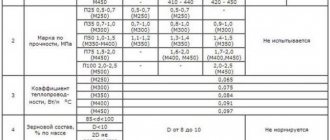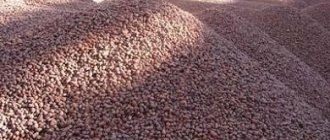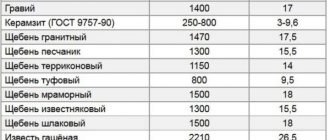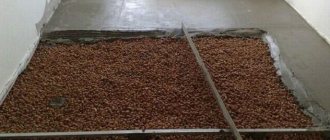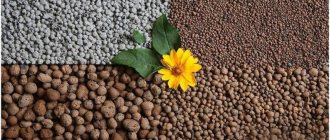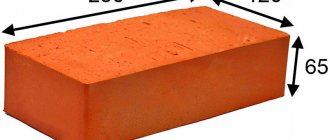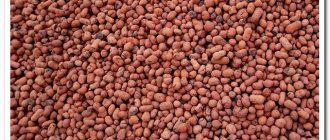To understand the density of expanded clay, its definition, correct calculation of the required volume or weight and applications of the material, it is useful to know its natural properties and history of appearance. Let's consider how expanded clay is classified depending on its characteristics, what are the advantages and features of its different types, how to choose the right grade based on density and strength that is optimal for your purposes.
Bulk expanded clay - a mixture of different fractions Source stroytorg-leon.ru
Helpful information
Density of expanded clay
The density of expanded clay depends on the size of its grains. The larger the gravel, the lower its bulk density. This is due to the fact that expanded clay of a large fraction includes granules that are more swollen during firing. Based on bulk density, expanded clay is divided into ten grades - from 100 to 600 kg/m3. And it is this indicator that helps determine the consumption of expanded clay when planning a construction project.
Specific gravity of expanded clay
The specific gravity of any substance is not a constant value and depends on the place and conditions of its measurement. Thus, you can find out exactly how much expanded clay weighs only by weighing it at the moment and under specific conditions of storage or use. On average, the specific gravity of expanded clay is 200-350 kg/m3.
The term “expanded clay volumetric weight” is also used for this indicator, since it shows the weight per unit volume of expanded clay. The weight of a bag of expanded clay is usually 10-12 kg.
Expanded clay thermal conductivity coefficient
The thermal conductivity of gravel may vary depending on the manufacturer, the quality of raw materials and manufacturing technology. The average value of this indicator varies from 0.08 to 0.14 W/(m K).
Frost resistance of expanded clay
Expanded clay is often used to insulate buildings and structures. GOST requires that the frost resistance index should not be lower than 15. This means that gravel can withstand 15 cycles in low temperature conditions. Manufacturers usually meet this standard.
Strength of expanded clay
Strength is determined by squeezing expanded clay with a special device - a punch - to a specific depth. In this case, the magnitude of the stress is recorded, which is considered the conditional strength of the gravel. Also, the strength of expanded clay can be determined by squeezing its individual granules with a press. High quality expanded clay usually has high strength.
keramzit.ru
Table of the weight of a cube of expanded clay depending on its density.
— Brand of density. Depending on the brand of density according to GOST, the specific gravity of m3 of expanded clay also differs: the higher the density of expanded clay, the greater the weight of the material in general. This can be traced, and you can also find out the approximate weight of a bag of expanded clay by density grade in table No. 2.
— Density of expanded clay.
Denser grades will have a specific gravity value higher than that of lower-strength expanded clay, due to low porosity. GOST also establishes various strength grades. Table No. 3 will help you calculate the strength and weight of the bag. Specific gravity and weight of a bag of expanded clay depending on the brand
| Density grade /Strength grade | Specific gravity (g /cm3) | Expanded clay bag weight (42 l) |
| M250 / P-25 | 0,2 – 0,25 | 8,4 – 10,5 |
| M300 / P-30, P-50 | 0,25 – 0,3 | 10,5 – 12,6 |
| M350 / P-50 | 0,3 – 0,35 | 12,6 – 14,7 |
| M400 / P-50 | 0,35 – 0,4 | 14,7 – 16,8 |
| M450 / P-75, P-100 | 0,4 – 0,45 | 16,8 – 18,9 |
| M500 / P-100, P-125 | 0,45 – 0,5 | 18.9 – 21 |
| M600 / P-125. P-150 | 0,5 – 0,6 | 21 – 25,2 |
| M700 / P-150, P-200 | 0,6 – 0,7 | 25,2 29,4 |
| M800 / P-200 | 0,7 – 0,8 | 29,4 – 33,6 |
| M900 / P-200 | 0,8 -0,9 | 33,6 -37,8 |
| M1000 / P-200 | 0,9 – 1 | 37,8 – 42 |
| M1100 / P-200 | 1 – 1,1 | 42 – 46,2 |
| M1200 / P-200 | 1,1 – 1,2 | 46,2 — 50,4 |
Why is it important to know the durability of a material?
Of course, the recommended brand of strength is recommended so that the developer himself determines which expanded clay concrete blocks to use in his construction.
Some people prefer to build even a one-story non-residential building from solid blocks of the highest grade of strength, since it is not the cost of the products that is important to them, but their quality and service life. And someone, without fear, erects a 3-story residential building from material with M35 strength.
In any case, if you use high-grade stones in the construction of any type of walls and buildings, their durability will last for a long time. This is better than saving once and then rebuilding the building or additionally increasing their thickness by laying another row of blocks, since the original blocks with low strength cannot withstand the load.
Briefly about the main thing
Expanded clay is a processed clay, a pure natural material, perfect for various types of construction work, has heat-insulating properties and other specific characteristics. Different fractions of expanded clay have different specific gravity, different grades, and the porosity of the pellets affects the density.
The determination of the density of this material is not entirely standard and familiar from physics. Having a classification of fractions and bulk weights of expanded clay grades, the required indicators for application are determined. The use of experience and scientific advice is required in any business.
Ratings 0
Types of concrete by specific gravity
The specific gravity of concrete is the total mass of all the components that make up it. The ratio of fillers and their characteristics are regulated by GOST 23464-79 and some SNiPs, depending on the specifics of the structures being constructed. Regulatory documents specify recipes for the production of various grades of concrete using various fillers.
In accordance with the classification by specific gravity, concrete mixtures are divided into:
- Particularly light - up to 1000 kg. Lightweight concrete includes materials with a cellular structure and aerated concrete. These compositions have low density and excellent thermal insulation properties. Due to their low weight, lightweight concrete is a popular material for the construction of cottages, garages, and outbuildings;
- Lightweight - from 1000 to 1800 kg. Porous structures are used as fillers in such concrete;
- Heavy - from 1800 to 2550 kg. The most popular concrete, widely used in multi-story construction and among private developers. It contains large and medium fillers, incl. crushed stone or gravel. The mass that heavy concrete has depends on the proportions of the components: the less sand in the composition, the heavier the concrete will be;
- Particularly heavy - more than 2550 kg. The filler in especially heavy concrete is rocks: magnetite, granite, basalt, barite, etc. The material has the highest density and is used for the construction of special objects.
Despite the proportions and technology for producing concrete mixture prescribed in GOST, in practice it is impossible to obtain such ideal concrete. Therefore, in addition to the weight of all components, when calculating the specific gravity of 1 m3, it is worth considering:
- viscosity level of the raw materials used for mixing;
- physical characteristics of fillers;
- hardening conditions;
- method of mixing the mixture;
- installation method, etc.
For example, 1 m3 of concrete laid by deep compaction will weigh more than 1 m3 of a similar mixture laid without compaction. The differences in weight will be minimal, so in most cases they can not be taken into account at the design stage. However, where the value of the mass of 1 m3 of concrete is of paramount importance, all these nuances are taken into account by designers.
What determines the price of the finished product?
The cost of the product depends on the fraction and weight of expanded clay, volumes of supplies, type of packaging, and transportation costs.
For your information. Regulatory documents allow products to be supplied in bulk and in packaged form. Multilayer paper or polyethylene bags should be used for packaging.
Technical characteristics of expanded clay
The wholesale price of 1 m3 of material within the Moscow urban district is:
| No. | Fraction sizes, mm | Price per 1 m3, rub. |
| 1 | Over 20 to 40 | 2080 |
| 2 | Over 10 to 20 | 2080 |
| 3 | Over 5 to 10 | 3375 |
| 4 | up to 5 | 4424 |
The material is often used for thermal insulation of floors. There are more than 270 raw material production plants around the world. The annual production volume is over 73 million m3 of construction products.
Floor insulation with expanded clay - diagram
Sorting material by fractions
The main characteristic is the specific gravity of expanded clay. The calculated value of the indicator depends on the particle size.
For information. Specific gravity is the ratio of the mass of a substance to its occupied volume.
Selection of expanded clay fractions
Factory products are sorted by particle size. Division into fractions is carried out according to the data in the presented table. The classification is based on State Standard (GOST) No. 32496-2013 dated January 1, 2015 “Porous aggregates for lightweight concrete.”
| Type of filler | Fraction sizes in mm |
| Sand | up to 5 inclusive |
| Crushed crushed stone (rounded granules) | over 5 to 10 inclusive |
| over 10 to 20 inclusive | |
| over 20 to 40 inclusive |
Sand is used as a filler for the production of heavy concrete mortars.
Crushed stone or gravel of small fractions is used to insulate attic coverings.
The product of larger fractions is used in the construction of roads and railways.
Concepts of specific and volumetric gravity
Density is often confused with the concepts of specific and volumetric gravity. The specific gravity of a material is the ratio of the weight of a substance to the volume it occupies. This value is measured in N/m3. The concepts of weight and mass from a physical point of view have a significant difference between themselves. However, on Earth, in everyday use, the weight of a substance is neglected. Therefore, the specific gravity of construction waste is measured by the ratio kg/m3.
Volumetric weight, which is also called overall weight, is a calculated value that reflects the density of the cargo. Given the same weight of an object, a less dense one will take up more space than a more dense one. Volumetric weight is compared with actual weight. The export documentation will indicate the highest of these indicators. Volumetric weight is calculated using the formula: (width*length*height)/5000.
Weight of light and ultra-light materials
The presented product is characterized by a more porous structure. 1 m3 of such material weighs 500-1800 kg. In the production of lightweight concrete, fillers such as tuff, pumice, and expanded clay are used. Light materials are used in the construction of partitions and walls of light buildings.
For ultra-light concrete per 1 m3 it will be up to 500 kg. Due to its low weight, it is possible to use perlite and vermulite as filler. Due to the fact that ultra-light concrete has low strength indicators, in the field of construction they can be used as a heat insulator, for example, when sealing joints and seams.
Separately, it is worth noting such types of materials as foam concrete and aerated concrete. Their mass is not large due to the presence of a cellular structure. The presence of pores in the materials under consideration is associated with the release of gases, which occurs during a chemical reaction in a solution or when preparing a solution with the addition of foam. The main advantages of foam concrete and aerated concrete remain a low level of thermal conductivity and a high vapor permeability coefficient.
Use of expanded clay in construction
- Thermal insulation of floors, ceilings, attics, basements;
- Thermal insulation of strip foundations and blind areas of houses;
- Thermal insulation of flat roofs, creating a slope on the roof;
- Production of expanded clay concrete blocks and lightweight concrete;
- Thermal insulation of soil - lawns and drainage on the site;
- Thermal insulation of communications; in case of repairs, expanded clay is reused;
- Hydroponics, expanded clay creates an optimal microclimate for plant roots.
When laying expanded clay, it should be protected from getting wet and absorbing moisture with a waterproofing film (polyethylene, roofing felt, etc.).
As you can see, the scope of application of this insulation in construction and in the home is diverse, which can be explained by the excellent thermal conductivity, environmental safety and strength of the insulation. In addition, the material is free-flowing and takes any shape; it can be used to fill any media. When used correctly, it can reduce heat loss in the room by 50-75%.
(5,00 out of 5)
Specifications
The material parameters are established by GOST 9757-90, which regulates the quality of porous building materials
Some indicators are not regulated, but still remain an important characteristic. Let's take a closer look at the main properties of expanded clay
- Factional composition. In total, three fractions of material have been established, having a size range of 5-10 mm, 10-20 mm, 20-40 mm. A separate category includes fractions that are rarely used in construction work. These include expanded clay granules and crushed stone with sizes from 2.5 to 10 mm, as well as a wide mixed fraction from 5 to 20 mm. Thermal insulating expanded clay layers used in the form of bulk mass are a mixture of all fractions - from 5 to 40 mm. This is due to the need to fill voids in the heat-insulating layer, which increases the rigidity of the structure and eliminates convection air currents.
- Expanded clay grades by bulk density (volumetric bulk density). A total of seven values are established: up to 250 kg/m3 - grade 250, from 250 to 300 kg/m3 - grade 300, similarly - grades 350, 400, 450, 500, 600. Grades 700 and 800 are not produced for general sale and are produced only upon agreement with the consumer. True density (true volumetric weight) is 1.5-2 times greater than bulk density. This parameter characterizes the density of the material without taking into account the gaps between granules or fragments of the material;
- Expanded clay grades by strength. For gravel, there are 13 grades, differing in strength when compressed in a cylinder. For crushed stone, 11 grades are standardized, having the same designations as gravel grades. The strength of crushed stone and gravel of the same brand varies. Thus, for grade P100, the compressive strength of gravel is from 2.0 to 2.5 MPa, while crushed stone is from 1.2 to 1.6 MPa. There is a relationship between expanded clay grades in terms of density and strength - an increase in density leads to an increase in strength. The relationship between brands is also regulated by the GOST 9757-90 standard, which eliminates the production of low-quality high-density expanded clay that breaks down under light load.
- Compaction coefficient is a value agreed with the consumer, which does not exceed 1.15 and is used to take into account the compaction of the expanded clay mass as a result of transportation or caking. The use of the coefficient is associated with frequent shipment of material by bulk volume, which is convenient for the sale of large quantities.
- Thermal conductivity is the most important parameter characterizing thermal insulation properties. For expanded clay, the thermal conductivity coefficient ranges from 0.10 to 0.18 W/(m?°C). The range of values is quite narrow, which indicates the high thermal insulation properties of the material. With increasing density, the thermal conductivity coefficient increases. This is due to a decrease in the number and volume of pores containing the main heat insulator - air.
- Water absorption is an important parameter showing the behavior of a material when exposed to water. Expanded clay is a relatively resistant material and is characterized by a water absorption value of 8-20%.
- Sound insulation - like most thermal insulation components, expanded clay has increased sound insulation. The best results are achieved when soundproofing a wooden floor, in which expanded clay acts as a layer between the outer part of the floor and the interfloor slab.
- Frost resistance - due to low water absorption and clay, which is the basis of the material, expanded clay has fairly high frost-resistant properties. Numerical values are not standardized by standards, since expanded clay is frost-resistant “by default.” Only the indicators of building stones that contain expanded clay - expanded clay blocks - are standardized.
The following video will tell you how to calculate how many cubes of expanded clay in a bag:
Fractions and their density
To accurately determine how much expanded clay is in 1 cube, you need to pay attention to its fraction. The grade of this material depends on its processing. In the oven, clay particles can be granulated and fired, and therefore have different sizes at the exit. Their size can range from 0 to 40 mm. The smallest pellets are called sand, slightly larger ones are called gravel, and if the particles are crushed, they are called crushed stone. It is worth noting that the fraction size affects the density. Accordingly, the smaller the grain, the more closely they adhere to each other.
When calculating how much a cube of expanded clay weighs, you also need to mention such a value as specific gravity. This parameter is not stable; it depends on the properties of the particles that were placed in one cubic meter of any container. This volume may include granules of different fractions. But their density can also be affected by different times spent in the firing kiln, so determine the weight of expanded clay in 1 m
3
only possible through weighing the cube.
In construction, the most common brand is with an average of 450 kg/m
3
. And the most dense brand of expanded clay is considered to be M1000, in which the weight of a cube of expanded clay is equivalent to one ton. The high density of the material indicates its denser composition, which indicates good strength, but at the same time its insulating qualities decrease. Accordingly, the fraction with the smallest density is characterized by high porosity, therefore the insulating properties of expanded clay are the highest. Thus, when purchasing this building material, you must take into account its brand. If questions arise regarding the marking, then it should be said that the weight of 1 cube of expanded clay is the same as its marking.
This is interesting: Concrete contact - consumption per 1 m2 of wall or floor
Advantages and disadvantages
The ratio of advantages and disadvantages of this material is unequal - there are more advantages, but it is worth noting that the disadvantages are quite significant, and one cannot turn a blind eye to them.
Advantages of the material
If we talk about positive qualities
expanded clay concrete, the following can be distinguished:
House made of expanded clay concrete at the final stage of construction Source stroyres.net
Disadvantages of expanded clay concrete
Despite all the advantages, the material is not without its disadvantages. Among them:
Expanded clay concrete blocks, like any building material, have their pros and cons, so the possibility of using them for the construction of a country house depends on the specific conditions of construction and operation of the constructed structure.
Construction of a house from expanded clay concrete Source asm.ru
You might be interested
Density
The density of expanded clay, like the density of expanded clay concrete blocks and panels, is a value that helps make an accurate calculation of the loads on the foundation. Due to its low density values, expanded clay has become one of the best materials.
Properties of expanded clay
Expanded clay in our country is a slightly undervalued material. It is mainly used as an auxiliary element, however, in the West, houses have been successfully built from it for a long time.
In this article we will look at the quality characteristics of expanded clay.
More information about expanded clay concrete
Expanded clay concrete is one of the environmentally friendly building materials that has many advantages. In this article we will look at the composition of the material. How much does 1 cube of expanded clay 10-20 weigh for dry screed, floor filling.
Weight of a cubic meter of concrete of various brands
According to GOST, heavy concrete is divided into grades M100-M600. The compositions of the brands differ in the amount of water, sand, filler, binder and Portland cement - usually M400 or M500.
Specific gravity M100-M600
| Brand | 1 cube (kg/m³) |
| M100 | 2494 |
| M150 | 2461 |
| M200 | 2432 |
| M250 | 2348 |
| M300 | 2389 |
| M350 | 2502 |
| M400 | 2376 |
| M500 | 2298 |
As can be seen from the table, concrete of different grades weighs differently, however, so insignificantly that in most cases this difference can be neglected. Developers, when making calculations that use the specific gravity of heavy concrete (any brand), take the average value of 2400 kg/m³ per 1 cubic meter.
Popular
Paint for ceramic tiles
Porous ceramics: advantages of the material and application
Concrete sheet: technical characteristics and application
Expanded clay bag weight
Very often, it is much more convenient for buyers to buy expanded clay in bags. This is due to many obvious advantages, for example, if you need a small amount of expanded clay or, for example, you are making a screed with expanded clay in an apartment, you can also save on delivery and storage space, for example, you can bring it yourself, unloading and loading is also easier, transport Expanded clay in bags is really very convenient.
The specific gravity of a bag of expanded clay is 0.05 m3. There are 20 bags of expanded clay in 1 m3. The weight of expanded clay of fraction 5 10, in bags with a volume of 0.05 m3 is 23-28 kg.
Application area
The finished product is obtained by firing clay at a temperature of 1200–1350°C. The manufactured product has thermal insulation, waterproofing and soundproofing properties. The special advantages of the substance are lightness and porosity. Weight of expanded clay in a volume of 1 m
3
does not exceed 450 kilograms.
It is used as a bulk building material for covering roads and park paths. It has gained particular popularity as a filler for lightweight concrete. In the household it is used as a decorative backfill for flowers.
Using expanded clay to cover park paths
How to prepare 1 m3 of expanded clay concrete for screed
Leveling the subfloor while simultaneously insulating it allows you to make a lightweight expanded clay concrete screed. It’s not difficult to do it yourself, the main thing is to maintain the correct proportions of the mixture. This will require the same components as for the preparation of ordinary concrete, only expanded clay, the same expanded clay, will serve as a coarse aggregate instead of crushed stone.
Selecting a Filler
Expanded clay for screed can be taken in any size up to 40 mm. However, to level the floor, it is better to take expanded clay sand with a grain size of 0-5 mm. It has high strength, and due to its small size it gives the solution looseness and facilitates the installation process. On the other hand, the larger the size of the clay granules, the lighter and warmer the concrete will be. But one cannot expect high quality from such a composition.
To solve this problem, you can perform a two-layer fill. After the screed is ready, it is brought to “zero” with a finishing layer of cement-sand mortar. In this case, the coating will be not only warm, but also perfectly smooth, with a more durable surface.
The thickness of the finishing fill does not exceed 30 mm, but you need to have time to do it before the main layer of expanded clay concrete sets so that they adhere firmly to each other. To do this, it is enough to divide the surface into separate sections, filling them in turn with both compositions.
Proportions
Expanded clay concrete is divided into grades from M50 to M250. But for the screed device, M100 is considered optimal. Brand identity is determined by the composition of the solution, that is, the ratio of all its components.
When calculating proportions, you should start from the volume of expanded clay, but the final strength of the concrete coating will be affected by the amount and brand of cement used. Only very strong material is suitable - M400 or M500 without additives (marked D0). And the more there is, the stronger the floor surface will be. However, here it is worth observing the golden mean, since with an increase in the ratio of binder to other components, the thermal insulation properties of expanded clay concrete decrease.
For floor insulation in residential buildings, the following composition of expanded clay concrete mixture is considered classic:
- 1 part cement and water;
- 3 parts sand;
- 2 – expanded clay.
But by varying the number of components, you can get a screed with different strength indicators. The mass ratio C:P:C for the main grades of expanded clay concrete looks like this:
| C:P:C ratio, kg | M75 | M100 | M150 |
| 220 : 300 : 600 | 330 : 320 : 630 | 430 : 420 : 720 |
Depending on the size of the selected expanded clay, the composition and proportions of expanded clay concrete per 1 m3 may differ slightly. The density of the clay aggregate will also have an impact - the lighter the expanded clay granules, the more cement will be required to obtain concrete of the required strength.
To determine the amount of materials, you will need to calculate the cubic capacity of the future screed. To do this, simply measure the floor surface area and multiply it by the average leveling height. Naturally, the thickness of the fill cannot be less than the maximum piece of expanded clay.
The ratio of expanded clay concrete components in volumetric terms does not differ from the proportions for classic heavy concrete. But due to the low density of the filler (400-600 kg/m3), the weight of the screed will be significantly less.
Cooking recommendations
When pouring expanded clay into the mixture, it is first soaked in water. To do this, the granules are poured into a separate container and left until their surface pores are saturated with moisture. You can speed up the soaking by stirring. This is done so that the granules do not take water from the solution, which is needed to hydrate the cement, and thereby weaken the concrete.
After some time, the remaining water is drained from the container, and cement pre-mixed with sand is added to the expanded clay. It is not advisable to fill them separately. But if it is not possible to prepare or buy dry sand cement, proceed as follows:
- The binder is poured into the expanded clay and the mixture is stirred until it dissolves.
- Add sand and mix thoroughly again.
- Add water.
When mixing expanded clay concrete with water, it is important not so much to observe the selected proportions for the screed, but to monitor the viscosity. Excess water will wash cement particles into the lower layers of the fill, weakening the floor surface
A rigid composition that does not contain enough moisture will be impossible to stir or lay down properly.
If you don’t want to bother with preparing a solution of expanded clay concrete, then if there is a large amount of work involved in installing a screed, you can buy a ready-made mixture. It will cost, depending on the brand, relatively inexpensively:
- M75 – 3100 rub/m3;
- M100 – 3200 rub/m3;
- M150 – 3400 rub/m3.
How much does reinforced concrete weigh?
These are buildings or individual finished products made of concrete with working and structural reinforcement (reinforced). They have high fire resistance and resistance to the negative effects of subzero temperatures. In them, the calculated forces from all impacts must be absorbed by concrete and working reinforcement (clause 3.8 of SP 63.13330.2012).
Based on the type of manufacturing, the structure is divided into:
Prefabricated structures
They are made from pre-prepared elements (reinforced concrete products), the installation of which is carried out on the construction site according to the project. Prefabricated concrete products include foundation blocks, piles, various slabs, and crossbars. To find out the weight of reinforced concrete structures, you need to refer to the documentation for a specific product.
Note: all concrete products manufactured at the plant are subject to marking.
Monolithic reinforced concrete structures
The peculiarity of this type of work is that the structures are made directly at the construction site by laying the mixture into formwork. This allows you to erect a building or structure of complex shape and non-standard planning solutions in the shortest possible time.
The process of creating monolithic structures includes the use of reinforcement, which serves to uniformly distribute stress and deformation.
Depending on the shape and purpose of the structure, the grade of concrete, as well as the selected reinforcement scheme, the weight of monolithic reinforced concrete will differ. The number of rods and their cross-section matter.
The amount of reinforcement in the reinforced concrete body is usually taken as a reference. Its weight is determined according to the table:
How to calculate the weight of concrete? Let's look at the example of a strip foundation made of monolithic reinforced concrete grade M350, reinforced with rods with a diameter of 12 mm.
The volume occupied by reinforcement per cubic meter of reinforced concrete is calculated by the formula:
π r 2 L = 3.14 (0.006) 2 16 = 0.0018 m3, where:
- r—reinforcement radius, m
- L - total length of reinforcement in 1 m3 of reinforced concrete, m
We take the data from the table presented above.
It turns out that concrete occupies 0.9982 m3.
- Then, the weight of reinforcement per 1 m3 of concrete: 7850 * 0.0018 = 14.13 kg,
- Where: 7580 is the density of steel, kg/m3
- and concrete 0.9982*2502 = 2497.50 kg.
- The weight of concrete M350 1 m3 is 2502 kg.
Thus, we obtain the weight of m3 of reinforced concrete: 14.13 + 2497.50 = 2511.63 kg.
Example: it is necessary to calculate the weight of a concrete screed 5 cm thick, class B20. From the table posted earlier, we determine that the specific gravity of 1 m3 of B20 concrete is 2348 kg/m3. Room area 15 m2. We get a weight of 15 * 0.05 * 2348 = 1761 kg - the weight of the concrete slab for this room.
Prefabricated monolithic structures
They consist of precast concrete products and cast-in-place concrete, which binds the entire structure together. The main role in this technology is played by the quality of adhesion between prefabricated elements and monolithic ones. Such structures combine the advantages of prefabricated and monolithic construction.
The weight in this case will depend on the components of the prefabricated monolithic structure.
Therefore, to determine it you need to:
- Calculate the weight of reinforced concrete products;
- Calculate monolithic concrete;
- Summarize the received data.
Note: the technology for constructing prefabricated monolithic buildings allows the use of blocks and slabs from various types of concrete, depending on the purpose. Monolithic sections are made of concrete not lower than M100 with fine-grained filler. The weight of 1 m3 of M 100 concrete is 2494 kg, and the weight of 1 m3 of B20 concrete is 2348 kg.
Volumetric weight table
If you compare different types of concrete, the difference in weight is obvious. When it comes to the weight of concrete M200 and M250, for example, the indicators may be the same, since the proportions are similar, and the result depends on the materials used and their density.
What affects the weight of concrete:
- Type and characteristics of filler
- Specific density of the mixture (dry) and when kneading
- Cement grade and corresponding component ratios
- Use of gas during the hardening process, foaming agents, plasticizers, etc.
When calculating the mass, it is allowed to take not only the brand of concrete, but also the class to which certain indicators of the monolith and the proportions of the components correspond. So, if class B15 concrete is being prepared, this automatically means that the result will be a mixture of grade M200 and all values are taken from it. Concrete class B20 corresponds to grade M250, concrete class B25 corresponds to grade M350. All data can be found in volume/specific gravity tables.
The higher the weight of a cubic meter of concrete, the higher, as a rule, the characteristics of the finished monolith are obtained. Concrete with high weight and density is durable, resistant to frost and moisture, and is used in various fields.
If a reinforced frame is used in construction work, up to 10% is added to the calculated weight of the materials - the average value reaches 2500 kilograms.
Average specific gravity by strength grade
Expanded clay is distinguished not only by the size of its fractions. The grade of strength also matters. Here it’s the other way around: the denser the material, the heavier it is. Consequently, the specific gravity will increase with increasing density grade:
Thus, if the bulk density was 0.2-0.25 g/cm3 (or 200-250 kg/m3), then the grade of building material is M250. A product with a weight of 300-350 kg/m3 belongs to the M350 brand. And then the same.
Specific density is a variable value. It is determined by the type of building material (that is, it will differ for different fractions of expanded clay material - gravel, sand and crushed stone). True density (Pu) is a constant value. This indicator just allows you to find out the average specific gravity. To calculate, you will need to divide the weight of the dry product by the volume, excluding pores.
The formula is: Pu=m/Va. Here Va is volume, m is mass.

